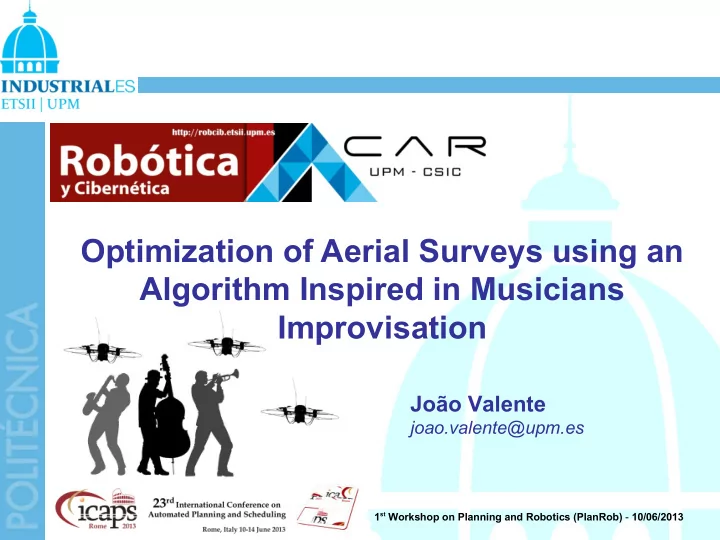

Optimization of Aerial Surveys using an Algorithm Inspired in Musicians Improvisation João Valente joao.valente@upm.es 1 st Workshop on Planning and Robotics (PlanRob) - 10/06/2013
Index 1. Introduction 2. Problematic 3. Harmony Search algorithm 4. The m-CPP algorithm 5. Results achieved 6. Conclusions 2/17
Introduction • Goal: – Compute trajectories for a fleet of mini aerial vehicles shipped with a digital camera subject to a set of restrictions – Mosaicking • Applications – Monitoring and inspections of Critical infrastructures – Precision agriculture • Projects: – ROTOS (Multi-Robot System for Large Outdoor Infrastructures Protection. DPI 2010-17998) – RHEA (Robot Fleets for Highly Effective Agriculture and Forestry Management. NMP-CP-IP 245986-2) 3/17
Problematic Full coverage trajectories ? 4/17
Harmony Search algorithm (I) Harmony Search algorithm (I) • Basic concepts Soft computing, Meta-heuristic approach • Inspired by the improvisation process of musicians • • Methodology Step 1: Initialization of the optimization problem [Lee, K. and Z. Geem, 2005] • Step 2: Initialization of the harmony memory (HM) • Step 3: Improvisation a New Harmony from the HM set • Step 4: Updating HM • Step 5: Repeat steps 3 and 4 until the end criterion is satisfied • Lee, K. and Z. Geem, 2005. A new meta-heuristic algorithm for continuous engineering optimization: 5/17 harmony search theory and practice. Comput. Methods Applied Mechanics Eng., 194: 3902-3933.
Harmony Search algorithm (II) Harmony Search algorithm (II) Step 1 : Initialization of the optimization problem Minimize F(x) subject to x i ∈ X i , i = 1,2,...N Where: F(x) : Objective function x : Set of each design variable (xi) Xi : Set of the possible range of values for each design variable (a < X i < b) N : Number of design variables 6/17
Harmony Search algorithm (III) Harmony Search algorithm (III) Step 2 : Initialization of the harmony memory (HM) Generate random vectors HMS: Harmony Memory Size 7/17
Harmony Search algorithm (IV) Harmony Search algorithm (IV) • Step 3 : Improvisation a New Harmony from the HM set New harmony vector, x' = (x 1 ', x 2 ',...,x n ' ) • • Three rules: Random selection Memory consideration HMCR: Harmony Memory Considering Rate Pitch adjustment PAR: Pitch Adjusting Rate 8/17
Harmony Search algorithm (V) Harmony Search algorithm (V) Step 4 : Updating HM F(X') < F(X) ? Step 5 : Repeat steps 3 and 4 until the end criterion is satisfied Stop criterion, Number of improvisations (NI) 9/17
(I) The m-CPP algorithm (I) The m-CPP algorithm Step 1: Initialization of the optimization problem – Employ HS algorithm to find the optimal coverage safe path Minimize J = J 1 +J 2 – • Subject to – x 1 and x i ,i = 1,...,N – Decision variables X {j} = [x 1 ,x 2 ,x 3 ,...,x i-2 ,x i-1 ,x i ], i=1,...,N; j=1,...,HMS 10/17
(II) The m-CPP algorithm (II) The m-CPP algorithm Step 2 : Initialization of the harmony memory (HM) Generate candidate permutations Random Breath Coverage algorithm Numerical example: X {1} = [1,2,3,6,9,8,7,4,1] 1 4 7 2 X 8 3 6 9 11/17
(III) The m-CPP algorithm (III) The m-CPP algorithm Step 3 : Improvisation a New Harmony from the HM set Random selection Memory consideration HMCR: Harmony Memory Considering Rate Pitch adjustment PAR: Pitch Adjusting Rate 12/17
(IV) The m-CPP algorithm (IV) The m-CPP algorithm Step 4 : Updating HM J(X') < J(X) ? Step 5 : Repeat steps 3 and 4 until the end criterion is satisfied Stop criterion Number of improvisations An admissible number of turns (a hypothesis) 13/17
Results achieved (I) Results achieved (I) Heuristic approach [7] m-CPP approach 6.7% 12.5% 59% 14/17
Results achieved (II) Results achieved (II) Removing borders [9] – Computing time • max 2 minutes per area – Area coverage • Improved – Cost • Improved for two • Worsened for one 15/17
Conclusions Conclusions A novel approach to ACPP employing HS algorithm – Improved previous approach – Improved airspace safety – Improved area coverage Computation time an issue • Large workspaces • Divide to conquer • Real time computing 16/17
Grazie mille!
Recommend
More recommend